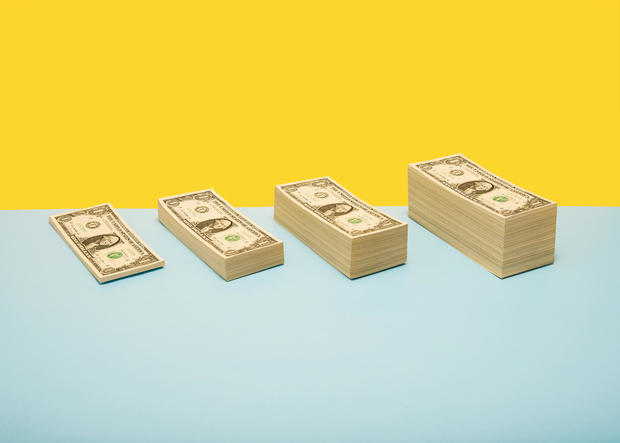CBS News
CDs vs. regular savings accounts: How much more could you be earning?

Getty Images
2023 was a tough year for borrowers. Thanks to elevated inflation and the decades-high interest rates designed to tame it, borrowers paid exponentially more for the credit they used than they would have just a few years earlier. But higher rates were beneficial for one group: savers.
Those who opened a high-yield savings or certificate of deposit (CD) account earned elevated returns throughout the year and, if they had a high-yield savings account, they saw that rate tick up numerous times. That said, rates on high-yield savings accounts are variable while rates on CDs are locked, guaranteeing that savers will earn that rate even if the overall rate climate changes.
So if you don’t have your money in one or both of these account types, chances are high that you’re losing money. That’s because the returns on regular savings accounts pale compared to what can be earned with some top CDs. But how much more could you be earning when comparing both account types? That’s what we will calculate below.
Start exploring your CD account options here and earn more on your money.
CDs vs. regular savings accounts: How much more could you be earning?
The short answer to this question? Many times more. Of course, the details will determine exactly how much more you could earn with a CD. But considering that the average regular savings account interest rate is just 0.47% currently and that CDs go as high as 7% for qualified borrowers, you’re likely losing money by not moving some (or all) to a CD account.
Here’s the difference in earnings based on a few rates and deposit amounts:
$1,000 deposit
- A high-yield savings account at 0.47% after one year: $4.70 for a total of $1,004.70
- A CD at 4.50% after one year: $45 for a total of $1,045.00
- A CD at 5% after one year: $50 for a total of $1,050.00
- A CD at 5.50% after one year: $55 for a total of $1,055.00
$5,000 deposit
- A high-yield savings account at 0.47% after one year: $23.49 for a total of $5,023.49
- A CD at 4.50% after one year: $225 for a total of $5,225
- A CD at 5% after one year: $250 for a total of $5,250
- A CD at 5.50% after one year: $275 for a total of $5,275
$10,000 deposit
- A high-yield savings account at 0.47% after one year: $46.99 for a total of $10,046.99
- A CD at 4.50% after one year: $450 for a total of $10,450
- A CD at 5% after one year: $500 for a total of $10,500
- A CD at 5.50% after one year: $550 for a total of $10,500
$20,000 deposit
- A high-yield savings account at 0.47% after one year: $93.99 for a total of $20,093.99
- A CD at 4.50% after one year: $900 for a total of $20,900
- A CD at 5% after one year: $1,000 for a total of $21,000
- A CD at 5.50% after one year: $1,100 for a total of $21,100
As these figures demonstrate, CDs are clearly superior to regular savings accounts right now. And remember, these calculations were completed on the assumption that the 0.47% variable rate on regular savings accounts will remain the same over the full year. If they change and drop (as many expect to happen) then your returns will be even lower. This is a major disadvantage when stacked against the guaranteed high returns CDs can provide right now.
Get started with a top CD account today.
The bottom line
When it comes to personal financial considerations, the decision is unique to each individual. That said, as the above calculations emphasize, there are major benefits to moving your money out of a regular savings account and into a CD now. And if you’re concerned about losing the flexibility your regular savings account provides, consider splitting your funds between a CD and a high-yield savings account. Just don’t let your money stagnate. Instead, take advantage of today’s high-rate environment before it changes.
Thanks for reading CBS NEWS.
Create your free account or log in
for more features.
CBS News
Hyundai, Kia recall more than 208,000 electric vehicles over power loss issue

Hyundai and Kia are recalling more than 208,000 electric vehicles to fix a problem that can cause the loss of drive power, increasing the risk of a crash.
The recall covers more than 145,000 Hyundai and Genesis including some IONIQ 5 and IONIQ 6 EVs along with Genesis GV60, Genesis GV70 and Genesis G80 models.
The National Highway Traffic Safety Administration (NHTSA) said the vehicles’ transistors in a charging control unit may get damaged and stop charging the 12-volt battery, “which can result in a loss of drive power.”
In the Kia recall, nearly 63,000 EV6 vehicles from 2022 through 2024 are impacted.
Car dealers will inspect and replace the control unit and a fuse if needed, as well as update software. Owners whose vehicles were recalled earlier this year to fix the same problem will have to visit their dealer again.
Owners will be notified by letter in December and January.
CBS News
Here Comes the Sun: Jack Antonoff and more

Watch CBS News
Be the first to know
Get browser notifications for breaking news, live events, and exclusive reporting.
CBS News
Capturing Moriah Wilson’s Killer – CBS News

Watch CBS News
Be the first to know
Get browser notifications for breaking news, live events, and exclusive reporting.



